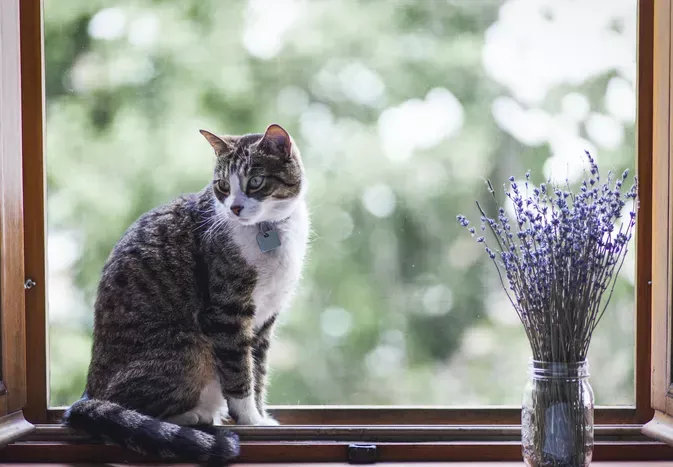Is Lavender Safe for Cats?
Updated on 04/26/24

Is Lavender Safe for Cats? Unraveling the Truth
Cats, with their enigmatic presence and captivating charm, often find themselves surrounded by a plethora of plants and essential oils, many of which may pose潜在的 hazards to their well-being. Lavender, a fragrant herb widely used for its calming and soothing effects, is one such plant that has raised concerns among cat owners. In this comprehensive exploration, we delve into the intricacies of lavender's interactions with cats, unraveling the truth behind its safety and potential risks.
The Allure of Lavender: A Fragrant Temptation
Lavender, renowned for its delicate purple blooms and captivating aroma, has been a beloved herb for centuries. Its versatility extends from culinary applications to aromatherapy and cosmetic products. The essential oil extracted from lavender flowers is particularly prized for its calming and relaxing properties, often used in diffusers and topical applications to promote sleep and reduce stress.
Lavender's Effects on Cats: A Complex Interplay
The relationship between lavender and cats is a complex one, with varying degrees of sensitivity and reactions observed among individual felines. While some cats may exhibit no adverse effects when exposed to lavender, others may experience a range of symptoms, including:
* Gastrointestinal upset: Ingesting lavender, whether in plant form or essential oil, can cause nausea, vomiting, and diarrhea in cats. The presence of linalool, a compound found in lavender, can irritate the digestive tract, leading to these symptoms.
* Skin irritation: Topical application of lavender essential oil, if not properly diluted, can cause skin irritation, redness, and itching in cats. The concentrated nature of essential oils can be harsh on their delicate skin.
* Neurological effects: In high concentrations, lavender essential oil can have sedative effects on cats, causing lethargy, disorientation, and even tremors. Inhalation of large amounts of lavender oil can lead to respiratory distress and potentially life-threatening situations.
Safeguarding Your Feline Companion: Minimizing Risks
Understanding the potential risks associated with lavender exposure in cats is crucial for responsible pet ownership. To ensure the safety of your furry friend, adhere to the following guidelines:
* Avoid ingestion: Keep lavender plants and essential oils out of reach of cats. Securely store essential oils in tightly sealed containers and avoid using diffusers in areas where cats have access.
* Dilute essential oils: If using lavender essential oil topically on cats, dilute it heavily with a carrier oil, such as coconut or olive oil, to minimize the risk of skin irritation. Always consult with a veterinarian before applying any essential oils to your cat.
* Monitor closely: Observe your cat closely after any exposure to lavender. If you notice any signs of gastrointestinal upset, skin irritation, or neurological effects, seek veterinary attention promptly.
Alternatives to Lavender: Exploring Safer Options
While lavender may not be the ideal choice for cats, there are numerous alternative plants and essential oils that offer similar calming and soothing effects without posing significant risks. Some safe options include:
* Chamomile: Chamomile, with its gentle and calming properties, can help reduce stress and promote relaxation in cats. It can be administered orally as a tea or applied topically as a diluted essential oil.
* Valerian root: Valerian root has been traditionally used as a natural sedative for cats. It can be given orally or added to catnip toys to promote relaxation and reduce anxiety.
* Catnip: Catnip, a plant specifically attractive to cats, has a euphoric and calming effect on many felines. It can be given as a treat or used in toys to provide stimulation and relaxation.
Conclusion: Striking a Balance
Navigating the use of lavender around cats requires a delicate balance between enjoying its potential benefits while prioritizing their safety. By adhering to the guidelines outlined above and exploring alternative options, cat owners can create a harmonious environment where their feline companions can thrive without compromising their well-being. Always remember to consult with a veterinarian for personalized advice and guidance on the use of essential oils or other natural remedies for your cat.
Explore More Pets

Cat Behavior Problems
How to Stop Aggression in Kittens

Long-Haired Cat Breeds
Siberian Cat: Breed Profile, Characteristics, & Care

Cat Behavior Problems
How to Stop Kittens From Scratching and Biting

Long-Haired Cat Breeds
Turkish Angora: Cat Breed Profile, Characteristics & Care

Basic Training
How to Socialize Your Kitten

Short-Haired Cat Breeds
Cute Pictures & Facts About Calico Cats & Kittens

Litter Box Training
Training Your Kitten to Use the Litter Box

Long-Haired Cat Breeds
10 Fun Facts About White Cats